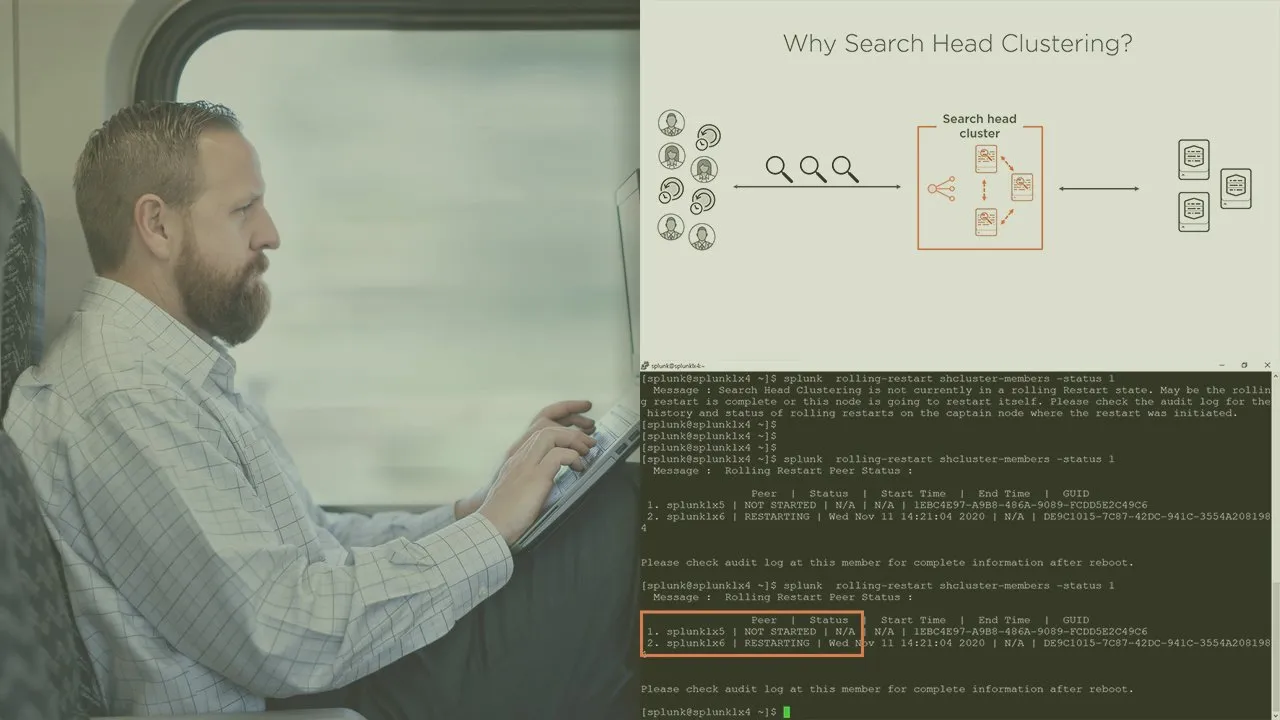
Splunk Search Head Clustering 
This course provides an in-depth look at configuring and administering a Splunk Search Head Cluster, including setting up the environment, configuring the cluster, and managing the cluster. ▼
ADVERTISEMENT
Course Feature
![]() Cost:
Cost:
Free Trial
![]() Provider:
Provider:
Pluralsight
![]() Certificate:
Certificate:
Paid Certification
![]() Language:
Language:
English
![]() Start Date:
Start Date:
On-Demand
Course Overview
❗The content presented here is sourced directly from Pluralsight platform. For comprehensive course details, including enrollment information, simply click on the 'Go to class' link on our website.
Updated in [April 29th, 2023]
This course will teach you how to configure and administer all the components of a Splunk Search Head Cluster. It will cover the purpose, important concepts, and architecture of a Search Head Clusters, as well as how to setup all the components of a Search Head Cluster, and how to monitor and administer a Search Head Cluster using the Splunk Web Interface and Command Line Interface.
Possible Development Directions:
By taking this course, you will gain the skills and knowledge needed to successfully configure and administer a Splunk Search Head Cluster. This will enable you to develop your career in the field of Splunk and become an expert in the field. You will also be able to use the knowledge gained to help your organization better manage and monitor their Splunk environment.
Related Learning Suggestions:
In addition to this course, you may also want to consider taking courses related to Splunk such as Splunk Fundamentals, Splunk Administration, and Splunk Data Modeling. These courses will help you gain a deeper understanding of Splunk and how to use it to its fullest potential. Additionally, you may want to consider taking courses related to other areas of IT such as Linux, Networking, and Security. These courses will help you gain a better understanding of the IT environment and how to use Splunk to its fullest potential.
[Applications]
After completing this course, participants should be able to apply their knowledge of Splunk Search Head Clustering to their own environment. They should be able to configure and administer all the components of a Splunk Search Head Cluster, as well as monitor and administer a Search Head Cluster using the Splunk Web Interface and Command Line Interface. Additionally, participants should be able to troubleshoot and resolve any issues that may arise with their Search Head Cluster.
[Career Paths]
1. Splunk Administrator: Splunk Administrators are responsible for the installation, configuration, and maintenance of Splunk software. They are also responsible for troubleshooting and resolving any issues that arise with the Splunk software. As the demand for Splunk increases, the need for Splunk Administrators is also increasing.
2. Splunk Developer: Splunk Developers are responsible for developing and customizing Splunk applications. They are also responsible for creating custom dashboards and reports, as well as developing custom scripts and applications. As the demand for Splunk increases, the need for Splunk Developers is also increasing.
3. Splunk Consultant: Splunk Consultants are responsible for providing advice and guidance to customers on how to best use Splunk software. They are also responsible for helping customers design and implement Splunk solutions. As the demand for Splunk increases, the need for Splunk Consultants is also increasing.
4. Splunk Architect: Splunk Architects are responsible for designing and implementing Splunk solutions. They are also responsible for developing and maintaining Splunk architectures, as well as providing guidance and advice on best practices. As the demand for Splunk increases, the need for Splunk Architects is also increasing.
[Education Paths]
1. Bachelor of Science in Computer Science: This degree path focuses on the fundamentals of computer science, such as programming, software engineering, and computer architecture. It also covers topics such as artificial intelligence, data structures, and algorithms. This degree path is becoming increasingly popular as the demand for skilled computer scientists continues to grow.
2. Master of Science in Data Science: This degree path focuses on the analysis and interpretation of large datasets. It covers topics such as machine learning, data mining, and statistical analysis. This degree path is becoming increasingly popular as businesses and organizations look to leverage data to make better decisions.
3. Master of Science in Information Systems: This degree path focuses on the design, implementation, and management of information systems. It covers topics such as database design, system security, and network architecture. This degree path is becoming increasingly popular as organizations look to leverage technology to improve their operations.
4. Master of Science in Cybersecurity: This degree path focuses on the protection of computer systems and networks from malicious attacks. It covers topics such as cryptography, network security, and digital forensics. This degree path is becoming increasingly popular as organizations look to protect their data and systems from cyber threats.
Course Provider

Provider Pluralsight's Stats at AZClass
Pluralsight ranked 16th on the Best Medium Workplaces List.
Pluralsight ranked 20th on the Forbes Cloud 100 list of the top 100 private cloud companies in the world.
Pluralsight Ranked on the Best Workplaces for Women List for the second consecutive year.
AZ Class hope that this free trial Pluralsight course can help your Splunk skills no matter in career or in further education. Even if you are only slightly interested, you can take Splunk Search Head Clustering course with confidence!
Discussion and Reviews
0.0 (Based on 0 reviews)
Explore Similar Online Courses

Lettering for Embroidered Patches: Make a Wearable Statement

Shopify Tutorial-Aliexpress Dropship Guide to Online Business

Python for Informatics: Exploring Information

Social Network Analysis

Introduction to Systematic Review and Meta-Analysis

The Analytics Edge

DCO042 - Python For Informatics

Causal Diagrams: Draw Your Assumptions Before Your Conclusions

Whole genome sequencing of bacterial genomes - tools and applications

Introduction to Splunk

Splunk: The Big Picture

Creating Workflow Actions in Splunk
 Related Categories
Related Categories
 Popular Providers
Popular Providers
Quiz
 Submitted Sucessfully
Submitted Sucessfully
1. What is the purpose of a Search Head Cluster?
2. What is the first step in setting up a Search Head Cluster?
3. Which of the following is used to monitor and administer a Search Head Cluster?
4. What is the purpose of a Splunk Search Head Cluster?
Correct Answer: To provide high availability and scalability for Splunk search operations.


Start your review of Splunk Search Head Clustering